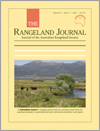RJ20024Riparian health improves with managerial effort to implement livestock distribution practices
 , Theresa A. Becchetti, Holly A. George, David F. Lile, Donald L. Lancaster, Neil K. McDougald and Kenneth W. Tate
, Theresa A. Becchetti, Holly A. George, David F. Lile, Donald L. Lancaster, Neil K. McDougald and Kenneth W. Tate
Degradation of sensitive habitats such as streams and riparian areas can occur in the absence of appropriate livestock management. In a study of 46 large grazing-management units, we found that managerial effort to improve livestock distribution was associated with significantly improved riparian health. Our results highlight that site-specific variation in managerial effort accounts for some of the observed variation in management effectiveness, and that appropriate managerial investments in grazing distributional practices can safeguard riparian health.
RJ20024 Abstract | RJ20024 Full Text | RJ20024PDF (446 KB) Open Access Article




